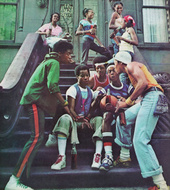
"Greater New York 2010" Exhibition
at MOMA PS1
in the Queens area
This event has ended - (2010-05-22 - 2010-10-18)

The 68 artists and collectives exhibiting at MoMA PS1’s “Greater New York” have filled the galleries, hallways and basement (even the elevator and boiler room). Most of the artists necessarily share the space, varying with one other or a half-dozen, creating all sorts of intriguing combinations. I noticed in my preliminary walk-through opening day that a fair chunk of the works were recognizable from previous gallery shows, including some just this past year. But seeing the art in a different space, juxtaposed against a seemingly unlikely other (whether by medium, discipline, subject matter), made them quite fresh again.
Case in point with David Benjamin Sherry. He showed at a four-artist manipulated photography exhibition at Sikkema, Jenkins & Co. this past March (alongside Mariah Robertson, also showing at “Greater New York”). At the time, I was impressed with Sherry’s dexterous color-soaked palette but the salon-style hanging and the visual assault of so many, many concentrated colors didn’t appeal to me aesthetically (as compared to Robertson’s fractured darkroom manipulations). However, Sherry’s inclusion here, lining the walls of Amy Yao’s room installation, totally works for me. His super-saturated C-prints (including Self Portrait As The Born Feeling Begins, 2009, used effectively in promotional materials for Greater New York) act as vacation photographs to Yao’s color-shifted prefab doors (Entryways to Exit Strategies, 2010). Yao’s own solo show at Jack Hanley Gallery this May overlapped slightly with this exhibition, though her contributions to “Greater New York” are even more hopped up on color. The cumulative effect is akin to living within a Lite-Brite and is conducive to Yao’s periodic performances (with collaborator Jacob Robichaux), where the “residence” becomes all the more apparent.
The shared Michele Abeles and Nick Mauss room, at first blush, is the antithesis to Yao’s and Sherry’s room, precisely a floor beneath it. Mauss’ white-painted wood and silk ribbon framework Depend, fasten, lower, suppose, dwell, (2010), is a more minimalist take on his installation from his late-2009 solo show at 303 Gallery. This forms a structural component to Abele’s prints, most from her current series “C.NOBODY” and most restrained in coloration and truncated in figuration (plus prosaically named, like Plant, Hand, Paper, Table, Lines, Numbers, 2009). I am impressed by the dialogue between these almost Dadaist “still lifes” (Abeles’) with Mauss’ L-shaped stage: the subdued atmosphere encourages much contemplation on our part.

Mariah Robertson’s abstracted-architectural prints (incredible processed-film interventions, a bit like James Rosenquist’s “Water Planet”-era shard paintings, only photo-based) were my favorite from that Sikkema, Jenkins & Co. show. Her works here, including the partially unfurled, 100′-long 88, 2010, despite their kinetic glow, play rather delicately off Caleb Considine’s restrained, representational paintings (which is decidedly in the minority at “Greater New York”), like Annie, 2010. The former donates some of its nighttime-vibe atmosphere to Considine’s muted canvases, which in turn grounds Robertson’s prints in their complicated, visual richness.
And despite the unmistakable vividness of the Yao-Sherry room, my vote for most colorful domain goes to Debo Eilers and Tamar Halpern. Fresh off a carnivalesque solo show at On Stellar Rays, Eilers’ acid-toned mixed media sculpture (like the waxy gatorboard Coolhaus (pink), 2010, series, suspended from chains like in a surreal nursery) are inclined to dominate any space they pervade. Eilers is tempered, however, by Halpern’s large ultra-chrome ink prints, like raspberry-jam explosions on enlarged photocopies. They’re more inclusively abstract than the fragmented prints at her show “Short Trip to Nowhere”, which just ended at D’Amelio-Terras, and they command your attention just as intensely as Eilers’ chaotically beautiful confections.
Some of these pairings, plus loads others in the exhibition, seem obvious on paper (put two color-hungry artists together…). But I found one of the most intriguing in a narrow room on the third floor, lined with black-and-white prints from LaToya Ruby Frazier and Alice O’Malley. I know Frazier best for her family portraiture, like her works in the New Museum’s “Younger Than Jesus” triennial. But her ongoing “The Notion of Family” series here focuses entirely on spaces — a dilapidated house (Home on Braddock Avenue, 2007) a mural in an overgrown lawn (The World is Yours, 2009) — yet retain the essence of those (unseen) who inhabited them. O’Malley’s extensive documentation of downtown figures — Kembra Pfahler, Nomi Ruiz, Bianca Casady, etc — in raw spaces or bare studios, bear similar familial interconnectivity, in their intrinsic ties to the Lower East Side and their past collaborations with the photographer.
A major challenge in these biennial-type exhibitions is fitting the entire roster in, juxtaposing unlikely artists from various galleries without them one-upping the other for visual (or contextual) command. This is largely successful at “Greater New York”, whose art-filled rooms inspire introspection amid an organic harmony. Get to know the artists: we’ll no doubt be seeing much more of them in the future.

Comments